The missile defense system "System" A "
A proposal to create a new missile defense system appeared in the middle of 1953, after which disputes began at various levels. Part of the military leadership and defense industry specialists supported the new idea, while some other commanders and scientists doubted that the task could be accomplished. Nevertheless, supporters of the new idea still managed to win. At the very end of 1953, a special laboratory for the study of missile defense issues was organized. By the beginning of 1955, the laboratory had developed a preliminary concept, on which it was proposed to carry out further work. In July of the same year, an order was issued by the Minister of Defense Industry to begin developing a new complex.
SKB-1 was allocated specifically for the necessary work from the KB-30. The task of this organization was the overall coordination of the project and the development of the main components of the new complex. During the first few months of its existence, SKB-30 was engaged in shaping the overall look of the new complex. At the beginning of 1956, a conceptual design of the complex was proposed, which determined the composition of its main tools and operating principles.
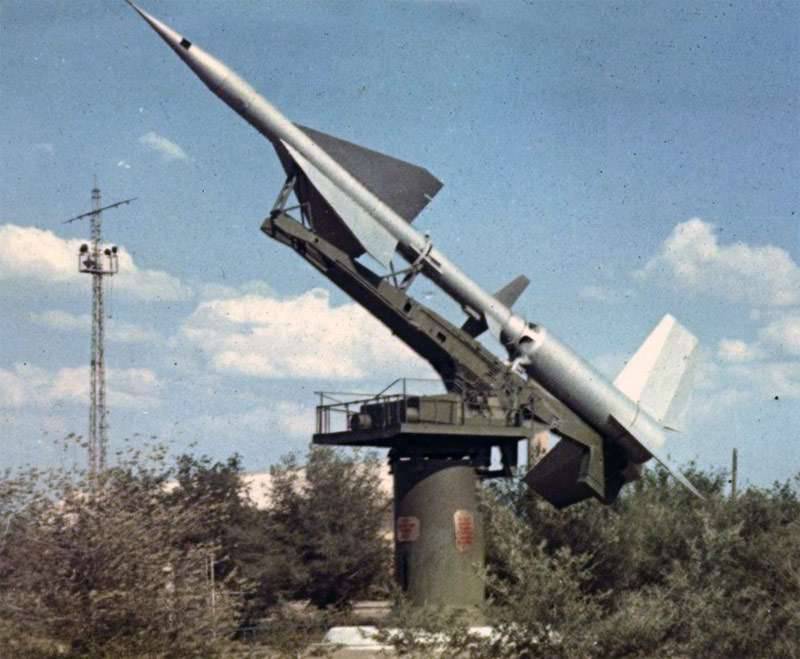
The B-1000 rocket on the SP-71M launcher, which is a monument. Photo Militaryrussia.ru
According to the results of the study of existing capabilities, it was decided to abandon the principle of homing anti-missiles. The technologies of that time did not allow the development of compact equipment with the required characteristics suitable for installation on a rocket. All operations to search for targets and control the antimissile should have been carried out using ground-based facilities of the complex. In addition, it was determined that the interception of the target should be carried out at an altitude of 25 km, which made it possible to dispense with the development of completely new equipment and techniques.
In the summer of 1956, the draft design of the antimissile system was approved, after which the CPSU Central Committee decided to start developing an experimental complex. The complex received the symbol "System" A ", the chief designer of the project was appointed G.V. Kisunko. The purpose of SKB-30 was now the completion of the project with the subsequent construction of an experimental complex at a new test site in the area of Lake Balkhash.
The complexity of the task affected the composition of the complex. In the system "A" it was proposed to include several objects of various purposes, which were to perform certain tasks, from searching for targets to destroying targets. To develop various elements of the complex, several third-party defense industry organizations were involved.
For the detection of ballistic targets on approach it was proposed to use a radar station with the corresponding characteristics. Soon for this purpose for the system "A" was developed radar "Danube-2". It was also proposed to use three precision-guided radars (RTN), which included stations for determining the coordinates of the target and anti-missiles. It was proposed to control the interceptor using radar output and sighting antimissile, combined with the command transmission station. It was proposed to defeat the targets using B-1000 missiles launched from appropriate installations. All facilities of the complex were to be combined with the help of communication systems and controlled by a central computing station.
Initially, the radar "Danube-2", created by SRI-108, was to become the main means of detecting potentially dangerous objects. The station consisted of two separate blocks located at a distance of 1 km from each other. One of the blocks was a transmitting part, the other - a receiving one. The detection range of medium-range missiles such as the Russian P-12 reached 1500 km. The coordinates of the target were determined to the accuracy of 1 km in range and to 0,5 ° in azimuth.
An alternative detection system was also developed in the form of a DSS radar. In contrast to the system "Danube-2", all elements of the CSO were mounted in the same building. In addition, over time, it was possible to provide some growth of the main characteristics in comparison with the base station.
To accurately determine the coordinates of the missile and the target, it was proposed to use three radar stations PTN, developed at NIIRP. These systems were equipped with two types of full-turn mirror antennas with mechanical drives, which were connected to two separate stations for tracking the target and antimissile. The coordinates of the target were determined using the PC-10 station, and the PC-11 system was responsible for tracking the missile. The RTN stations should be built on the test site at a distance of 150 km from each other in such a way that they form an equilateral triangle. In the center of this triangle was the aiming point of the intercepted missiles.
The RTN stations had to operate in the centimeter range. Object detection range reached 700 km. The estimated accuracy of measuring the distance to the object reached 5 m.
The central computer station of system “A”, which was responsible for managing all the facilities of the complex, was based on the electronic computer M-40 (alternative designation 40-CEC). A computer with a speed of 40 thousand operations per second was able to track and track eight ballistic targets simultaneously. In addition, she had to develop teams for PTN and anti-missiles, controlling the latter until the moment of hitting the target.
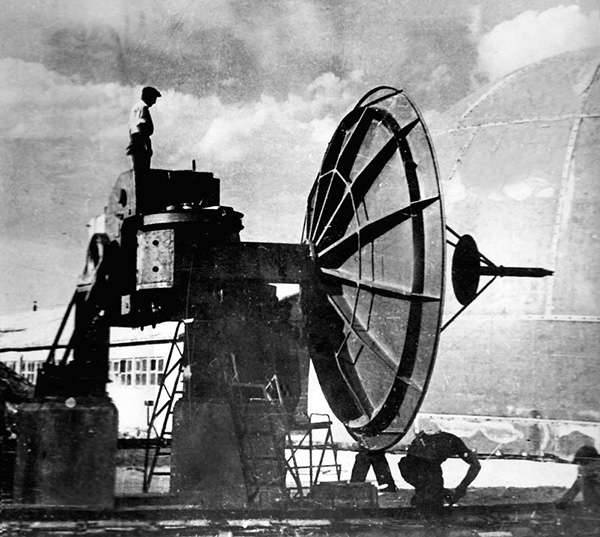
Antenna radar P-11. Photo Defendingrussia.ru
As a means of hitting targets, a guided missile B-1000 was developed. It was a two-stage product with a solid-fuel starting engine and a liquid-propulsion marching stage. The rocket was built on a bicalyber scheme and equipped with a set of planes. So, the marching stage was equipped with a set of wings and rudders of an X-shaped design, and three stabilizers were provided at the starting accelerator. In the early stages of testing, the B-1000 rocket was used in a modified version. Instead of a special starting stage, it was equipped with a block of several solid-fuel accelerators of the existing structure.
The control of the rocket was to be carried out by the auto-pilot of the APV-1000 with course correction for commands from the ground. The autopilot's task was to track the position of the rocket and issue commands to pneumatic steering gears. At a certain stage of the project, the development of alternative missile control systems using radar and thermal homing heads began.
For the anti-missile B-1000 developed combat units of several types. A number of design teams tried to solve the problem of creating a high-explosive fragmentation system capable of effectively hitting ballistic targets with their complete destruction. The high rate of convergence of the target and the anti-missile missiles, as well as a number of other factors, seriously hampered the destruction of the dangerous object. In addition, it was necessary to eliminate the possible undermining of the nuclear warhead of the target. The work resulted in several versions of the warhead with different striking elements and charges. In addition, a special combat unit was proposed.
The B-1000 missile had a length of 15 m and a maximum wingspan of more than 4 m. The launch weight was 8785 kg with a launch stage weighing 3 t. The mass of the warhead was 500 kg. Technical requirements for the project asked the firing range of at least 55 km. The actual interception range reached 150 km with the maximum possible flight range to 300 km. Solid fuel and liquid engines of two stages allowed the rocket to fly at an average speed of the order of 1 km / s and accelerate to 1,5 km / s. The interception of the target was to be carried out at altitudes of about 25 km.
To launch the rocket, the SP-71M launcher was developed with the possibility of targeting in two planes. Start was carried out with a short guide. On the combat positions could be placed several launchers, controlled by a central computing system.
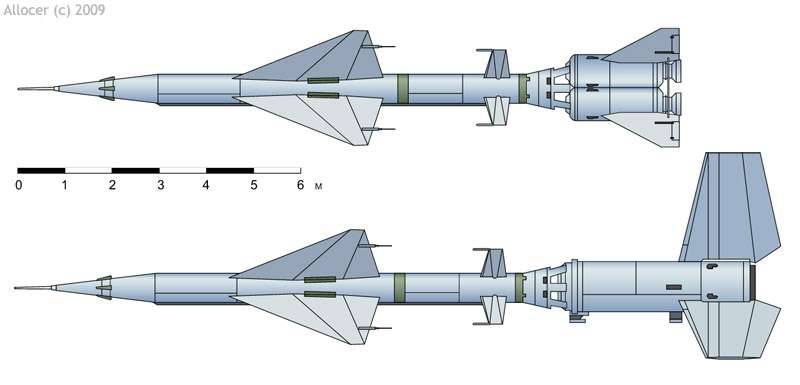
Rocket B-1000 in a configuration for throwing tests (above) and in a full-fledged serial modification (below). Figure Militaryrussia.ru
The process of detecting a dangerous object and its subsequent destruction should have been as follows. The task of the radar "Danube-2" or CSO was tracking the space and the search for ballistic targets. After finding the target, data about it should be transmitted to the central computing station. After processing the received data, the computer M-40 gave the command for PTH, according to which they began to determine the exact coordinates of the target. With the help of PTH, system “A” was to calculate the exact location of the target used in further calculations.
Having determined the prolonged trajectory of the target, the center would have to give the command to retreat the launchers and launch rockets at the right time. It was proposed to control the rocket with the help of an autopilot with correction on commands from the ground. At the same time, the RTN stations should have monitored both the target and the anti-ballistic missile, and the PBC should determine the necessary amendments. The rocket control commands were transmitted using a special station. At the approach of the rocket to the preemptive point of the control system were to give a command to undermine the warhead. When a field of fragments was formed or the nuclear part exploded, the target should have received fatal damage.
Soon after the release of the resolution on the start of construction of the experimental complex at about. Balkhash in the Kazakh SSR started construction work. The task of the builders was the arrangement of many different positions and objects for various purposes. Construction of facilities and installation of equipment continued for several years. In this case, the tests of the individual means of the system “A” were conducted as they were completed. At the same time, some inspections of individual elements of the complex were carried out at other sites.
In 1957, the first launch launches of special B-1000 rocket models, distinguished by a simplified design, took place. Until February 1960, 25 missile launches were performed using only the autopilot, without control from the ground. In the course of these checks, it was possible to ensure that the rocket was raised to a height of up to 15 km and accelerated to maximum speeds.
At the beginning of 1960, the construction of a target detection radar and launch missiles for antimissiles was completed. Soon were completed and mounted RTN. In the summer of the same year, inspections of the Danube-2 and RTN stations began, during which several types of ballistic missiles were tracked and tracked. However, some work was carried out earlier.
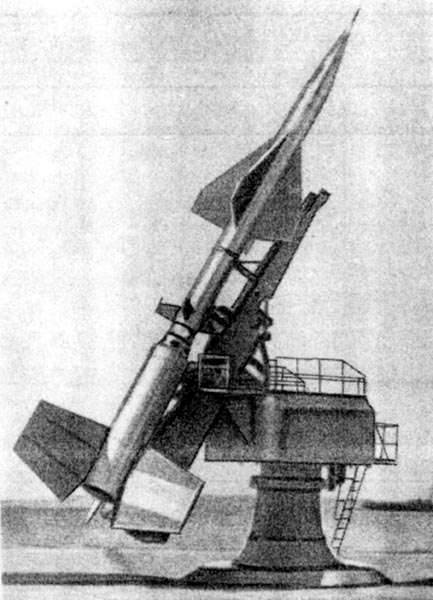
Anti-missile on the launcher. Photo Pvo.guns.ru
The completion of the construction of the main systems of the complex allowed the commencement of full-fledged tests with missile launches and radio command control of them. In addition, in the first half of 1960, trial training interceptions began. According to reports, on May 12 for the first time launched the B-1000 antimissile on a medium-range ballistic missile. For several reasons, the start failed.
In November, 1960 had two new attempts at firing an interceptor missile at a ballistic target. The first such test failed because the P-5 rocket did not reach the test site. The second launch did not end with the defeat of the target due to the use of a non-standard warhead. In this case, two missiles dispersed at a distance of several tens of meters, which allowed us to hope for a successful defeat of the target.
By the beginning of 1961, it was possible to carry out the necessary improvements in the design of products and the algorithms of their work, which made it possible to achieve the required effectiveness of hitting ballistic targets. Due to this, most of the subsequent launches of the 61 of the year ended with the successful defeat of ballistic missiles of various types.
Of particular interest are the five launches of B-1000 rockets, performed at the end of October on 1961 and in the autumn of 1962. As part of Operation K, several missiles were fired with special combat units. The explosions of combat units were carried out at altitudes of 80, 150 and 300 km. It also monitored the results of a high-altitude detonation of a nuclear warhead and its impact on various anti-missile systems. So, it was found that radio-relay communication systems of complex "A" do not stop their work when exposed to an electromagnetic pulse. The radar stations, in turn, stopped their work. The meter range systems were switched off for tens of minutes, others for a shorter time.
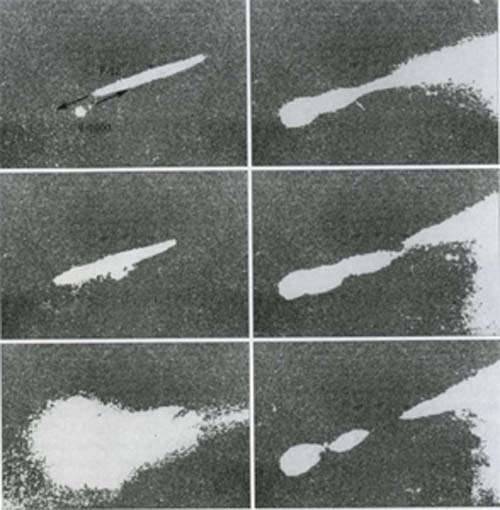
Destruction of the P-1000 ballistic missile by the B-12 interceptor, frames taken at 5 intervals of milliseconds. Photo of Wikimedia Commons
Tests of "System" A "showed the fundamental possibility of creating an anti-missile defense system capable of intercepting medium-range ballistic missiles. Such results allowed the development of advanced missile defense complexes with enhanced characteristics that could be used to protect important areas of the country. Further work on the complex "A" at the same time were considered inexpedient.
The fifth launch in the framework of Operation K turned out to be the last use of B-1000 missiles. In the course of inspections, 84 anti-missile missiles were used in several versions, differing from each other in equipment, engines, etc. In addition, at different stages of testing, combat units of several types were tested.
At the end of 1962, all work on the “System“ A ”project was discontinued. This project was developed for experimental purposes and was intended to test the basic ideas that were proposed to be used in the creation of new anti-missile systems. The operation of objects at the site for its intended purpose has ceased. However, radar stations and other systems were used for other purposes for a long time. They were used for tracking artificial Earth satellites, as well as in some new research. Also in the future, the objects "Danube-2" and TsSO-P were involved in new projects of anti-missile systems.
With extensive use of the experience gained in the framework of the pilot project "A", the new A-35 Aldan anti-missile defense system was soon developed. Unlike its predecessor, which was built only for testing, the new complex passed all tests and was put into service, after which for several decades was engaged in the protection of strategically important facilities from a possible nuclear missile strike.
On the materials of the sites:
http://pvo.guns.ru/
https://defendingrussia.ru/
http://old.vko.ru/
http://raspletin.com/
http://militaryparitet.com/
http://militaryrussia.ru/blog/topic-340.html
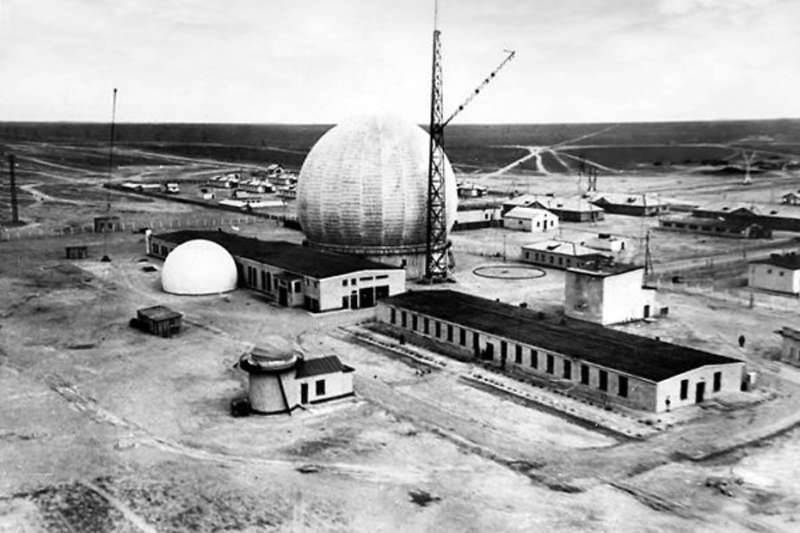
Information